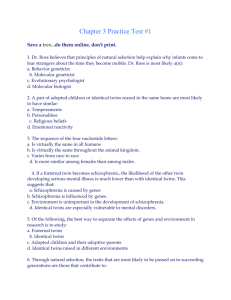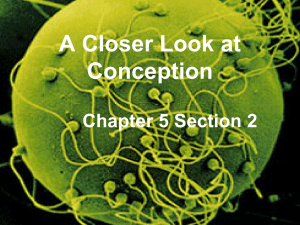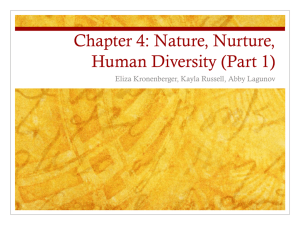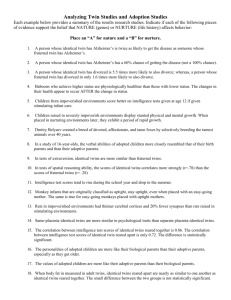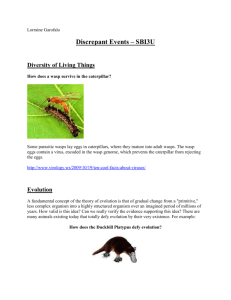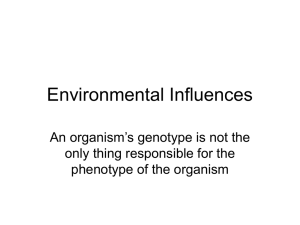Answer Key - Lone Star College System
advertisement
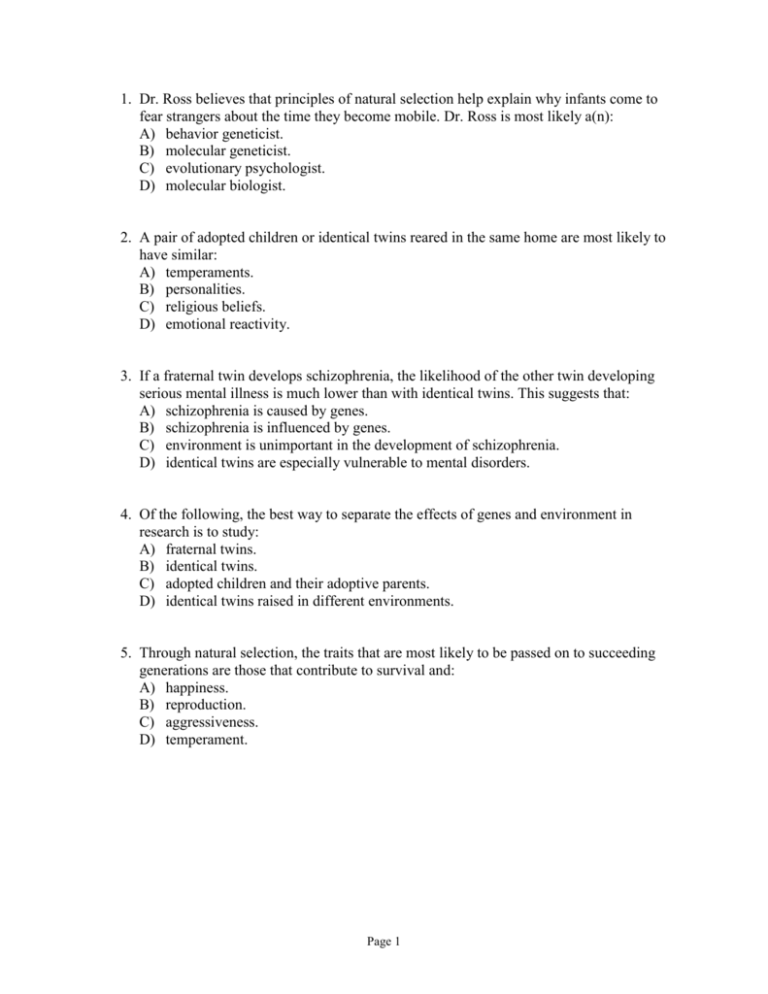
1. Dr. Ross believes that principles of natural selection help explain why infants come to fear strangers about the time they become mobile. Dr. Ross is most likely a(n): A) behavior geneticist. B) molecular geneticist. C) evolutionary psychologist. D) molecular biologist. 2. A pair of adopted children or identical twins reared in the same home are most likely to have similar: A) temperaments. B) personalities. C) religious beliefs. D) emotional reactivity. 3. If a fraternal twin develops schizophrenia, the likelihood of the other twin developing serious mental illness is much lower than with identical twins. This suggests that: A) schizophrenia is caused by genes. B) schizophrenia is influenced by genes. C) environment is unimportant in the development of schizophrenia. D) identical twins are especially vulnerable to mental disorders. 4. Of the following, the best way to separate the effects of genes and environment in research is to study: A) fraternal twins. B) identical twins. C) adopted children and their adoptive parents. D) identical twins raised in different environments. 5. Through natural selection, the traits that are most likely to be passed on to succeeding generations are those that contribute to survival and: A) happiness. B) reproduction. C) aggressiveness. D) temperament. Page 1 6. Which of the following is not true regarding gender and sexuality? A) Men more often than women attribute a woman's friendliness to sexual interest. B) Women are more likely than men to cite affection as a reason for first intercourse. C) Men are more likely than females to initiate sexual activity. D) Gender differences in sexuality are noticeably absent among gay men and lesbian women. 7. Evolutionary psychologists attribute gender differences in sexuality to the fact that women have: A) greater reproductive potential than do men. B) lower reproductive potential than do men. C) weaker sex drives than men. D) stronger sex drives than men. 8. According to evolutionary psychology, men are drawn sexually to women who seem ________, while women are attracted to men who seem ________. A) nurturing; youthful B) youthful and fertile; mature and affluent C) slender; muscular D) exciting; dominant 9. Unlike ________ twins, who develop from a single fertilized egg, ________ twins develop from separate fertilized eggs. A) fraternal; identical B) identical; fraternal C) placental; nonplacental D) nonplacental; placental 10. Temperament refers to a person's characteristic: A) emotional reactivity and intensity. B) attitudes. C) behaviors. D) role-related traits. 11. When evolutionary psychologists use the word “fitness,” they are specifically referring to: A) an animal's ability to adapt to changing environments. B) the diversity of a species' gene pool. C) the total number of members of the species currently alive. D) our ability to survive and reproduce. Page 2 12. Physiological tests reveal that anxious, inhibited infants: A) become less physiologically aroused when facing new situations. B) have slow, steady heart rates. C) have high and variable heart rates. D) have underreactive nervous systems. 13. Each cell of the human body has a total of: A) 23 chromosomes. B) 23 genes. C) 46 chromosomes. D) 46 genes. 14. Genes direct our physical development by synthesizing: A) hormones. B) proteins. C) DNA. D) chromosomes. 15. The human genome is best defined as: A) a complex molecule containing genetic information that makes up the chromosomes. B) a segment of DNA. C) the complete instructions for making an organism. D) the code for synthesizing protein. 16. Most human traits are: A) learned. B) determined by a single gene. C) influenced by many genes acting together. D) unpredictable. 17. Mutations are random errors in ________ replication. A) gene B) chromosome C) DNA D) protein Page 3 18. Casual, impulsive sex is most frequent among: A) males with high circulating levels of testosterone. B) males with traditional masculine attitudes. C) females and males who are weakly gender-typed. D) females and males who are strongly gender-typed. 19. Evolutionary explanations of gender differences in sexuality have been criticized because: A) they offer “after-the-fact” explanations. B) standards of attractiveness vary with time and place. C) they underestimate cultural influences on sexuality. D) of all of these reasons. 20. Several studies of long-separated identical twins have found that these twins: A) have little in common, due to the different environments in which they were raised. B) have many similarities, in everything from medical histories to personalities. C) have similar personalities, but very different likes, dislikes, and lifestyles. D) are no more similar than fraternal twins reared apart. 21. Adoption studies show that the personalities of adopted children: A) closely match those of their adoptive parents. B) bear more similarities to their biological parents than to their adoptive parents. C) closely match those of the biological children of their adoptive parents. D) closely match those of other children reared in the same home, whether or not they are biologically related. 22. Chromosomes are composed of small segments of: A) DNA called genes. B) DNA called neurotransmitters. C) genes called DNA. D) DNA called enzymes. 23. When the effect of one factor (such as environment) depends on another (such as heredity), we say there is a(n) ________ between the two factors. A) norm B) positive correlation C) negative correlation D) interaction Page 4 24. An evolutionary psychologist would be most interested in studying: A) why most parents are so passionately devoted to their children. B) hereditary influences on skin color. C) why certain diseases are more common among certain age groups. D) genetic differences in personality. 25. If chromosomes are the “books” of heredity, the “words” are the ________. A) genes B) molecules C) genomes D) DNA 26. After comparing divorce rates among identical and fraternal twins, Dr. Alexander has concluded that genes do play a role. Dr. Alexander is most likely a(n): A) evolutionary psychologist. B) behavior geneticist. C) molecular geneticist. D) divorcee. 27. One of the best ways to distinguish how much genetic and environmental factors affect behavior is to compare children who have: A) the same genes and environments. B) different genes and environments. C) similar genes and environments. D) the same genes but different environments. 28. My sibling and I developed from a single fertilized egg. Who are we? A) opposite sex identical twins. B) same-sex identical twins. C) opposite sex fraternal twins. D) same-sex fraternal twins. 29. A psychologist working from the evolutionary perspective is likely to suggest that people are biologically predisposed to: A) protect their offspring. B) like sweets. C) be attracted to fertile-appearing members of the opposite sex. D) do all of these answers. Page 5 30. Of the relatively few genetic differences among humans ________ are differences among population groups. A) less than 1 percent B) less than 10 percent C) approximately 25 percent D) approximately 40 to 50 percent 31. Responding to the argument that gender differences are often by-products of a culture's social and family structures, an evolutionary psychologist is most likely to point to: A) our great human capacity for learning. B) the tendency of cultural arguments to reinforce traditional gender inequalities. C) the infallibility of hindsight explanations. D) all of these answers. 32. A person whose twin has Alzheimer's disease has ________ risk of sharing the disease if they are identical twins than if they are fraternal twins. A) less B) about the same C) much greater D) It is unpredictable. 33. Which of the following is an example of an interaction? A) Swimmers swim fastest during competition against other swimmers. B) Swimmers with certain personality traits swim fastest during competition, while those with other personality traits swim fastest during solo time trials. C) As the average daily temperature increases, sales of ice cream decrease. D) As the average daily temperature increases, sales of lemonade increase. 34. Which of the following most accurately summarizes the findings of the 40-year fox-breeding study described in the text? A) Wild wolves cannot be domesticated. B) “Survival of the fittest” seems to operate only when animals live in their natural habitats. C) By mating aggressive and unaggressive foxes, the researchers created a mutant species. D) By selecting and mating the tamest males and females, the researchers have produced affectionate, unaggressive offspring. Page 6 35. Compared to men, women are more likely to: A) be concerned with their partner's physical attractiveness. B) initiate sexual activity. C) cite “liking one another” as a justification for having sex in a new relationship. D) be less accepting. Page 7 Answer Key 1. 2. 3. 4. 5. 6. 7. 8. 9. 10. 11. 12. 13. 14. 15. 16. 17. 18. 19. 20. 21. 22. 23. 24. 25. 26. 27. 28. 29. 30. 31. 32. 33. 34. 35. C C B D B D B B B A D C C B C C A B D B B A D A A B D B D B A C B D D Page 8
